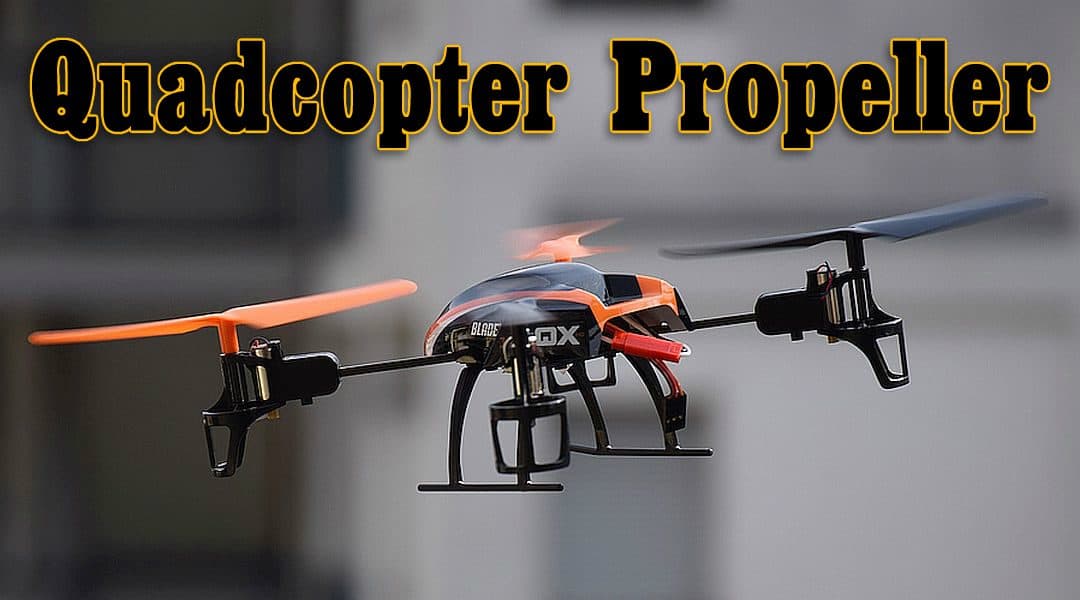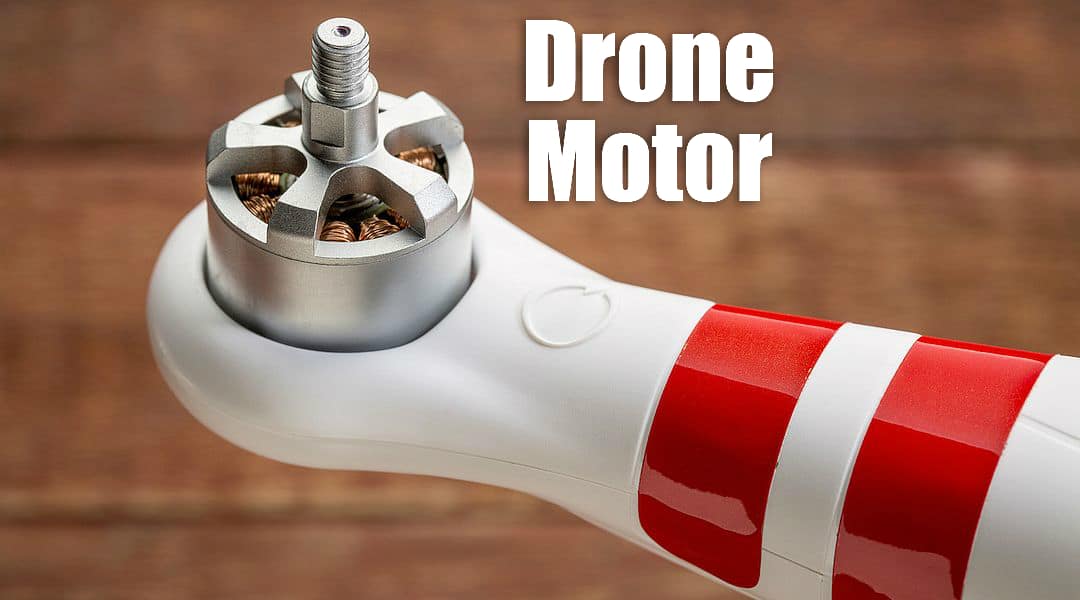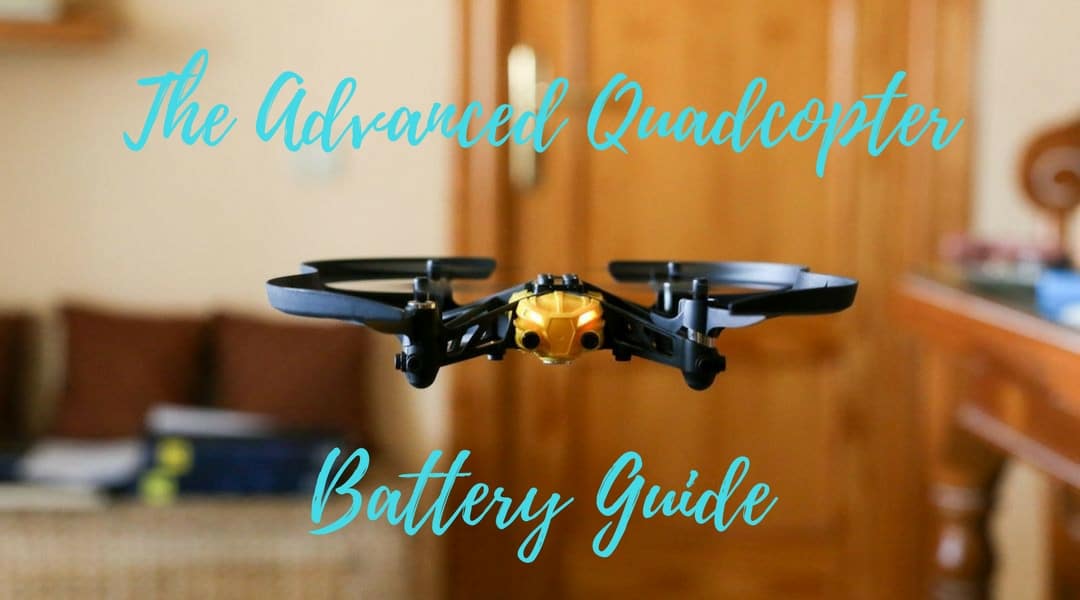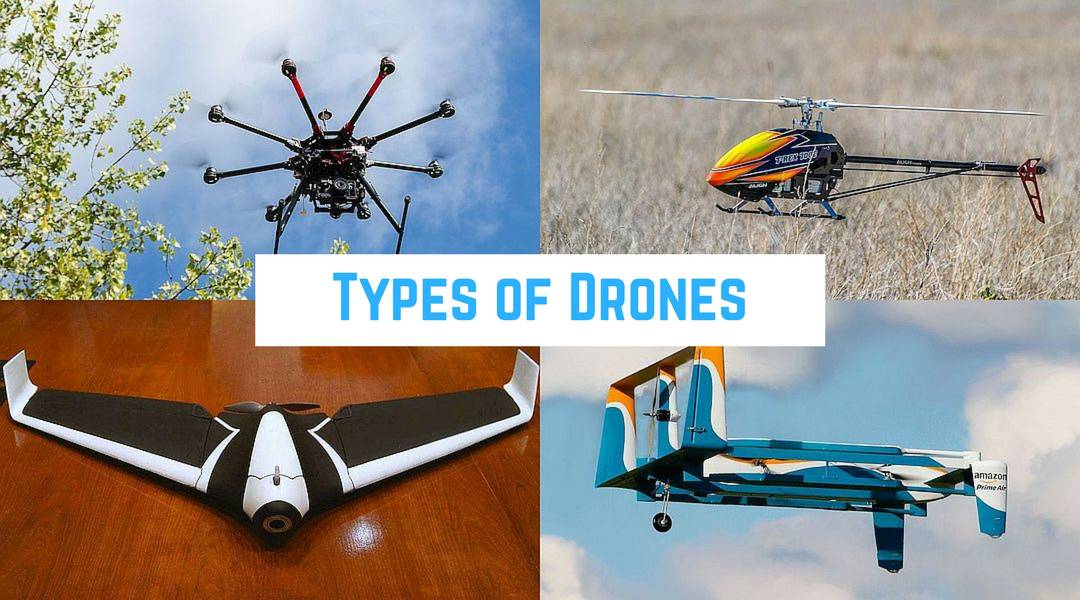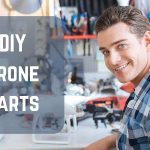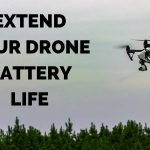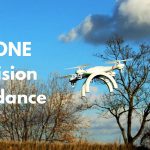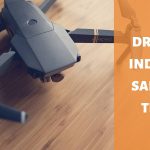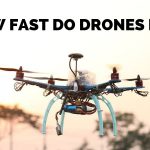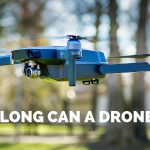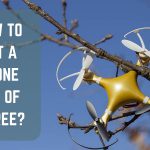Quadcopter Propeller Introduction
The purpose of your quadcopter propellers is to generate thrust and torque to keep your drone flying, and to maneuver.
The upward thrust force generated by the propellers is usually measured in pounds or grams. To keep your drone flying at a hover, the upward thrust needs to equal the weight of your drone. The thrust to weight ratio TWR (thrust divided by weight), indicates how much thrust your drone generates relative to its weight. A good rule of thumb is to design the TWR to be at least a value of two.
Typically, quadcopter propellers produce more thrust the faster they spin. They are also influenced by the flight dynamics of your quadcopter. Some propellers produce much more thrust when the drone is stationary, as opposed to when it is flying. Other props perform much better at higher speeds.
Torque is generated when the propellers accelerate up or down. This force is responsible for the ability of the drone to rotate on the yaw axis. Torque is an effect of Newton’s third law, where every action has an equal and opposite reaction. As the propeller rotates, and pushes through the air, the air pushes back and causes a counter rotation
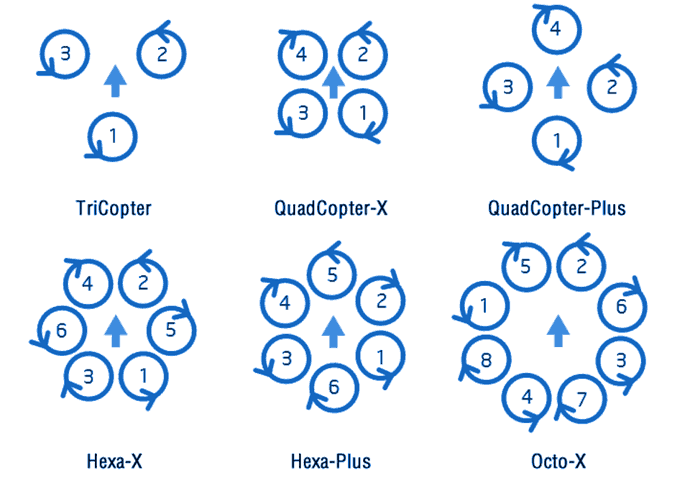
Fig 1. Multirotor Propeller Rotation
Your drone has two different types of propellers and motors. One set is designed to spin clockwise, while the other is designed to spin
Quadcopter Propeller Pitch
The quadcopter propeller pitch is a measurement of how far that a propeller will move through the air for every single rotation of the motor/propeller. This is only a theoretical approximation since
The higher the pitch value, the faster your plane will go.
To better understand the effect of propeller pitch, imagine two wood screws as shown in Figure 2. The screw on the left has a coarse thread (higher pitch), and the screw on the right has a finer thread (lower pitch). If you were to take a

Fig 2. Propeller Pitch
This is the same effect as a propeller cutting through the air.
In the figure, the two arrow lines show the position of the propeller tips. You can see that the high pitch propeller covers the same distance
Changing the propeller pitch will also change the dynamic response of your quadcopter.
To produce the required thrust, a quadcopter propeller needs to be designed to be within a specific range of pitch angles. An almost flat propeller will be just as bad as a
The flatter the blade, the easier it is for the motor to rotate the blade through the air. Toy grade or low-end quadcopters are equipped with low power motors. These motors need to spin faster to create lift, but higher RPMs are easier to generate with a smaller motor than torque.
Quadcopter Propeller Size
The size of the propeller is the distance from tip to tip. Longer propellers can generate more thrust at the same
The surface area of the propeller also determines how much thrust it can generate. The higher surface area allows more air to be moved, thereby generating more thrust. This also comes at the cost of more power draw from the motor.
The length of your quadcopter frame determines the maximum size of propeller that you can use. This can easily be determined by taking the smallest of the length or width of your drone frame, and dividing by 2. Then you need to make this slightly smaller to provide rotation clearance between adjacent propellers.
For a square frame configuration (see Figure 3), the maximum propeller size is X/2.
For a rectangular frame configuration (see Figure 4), you take the smallest of the length or width dimension, in this

Fig 3. Frame and Prop Size
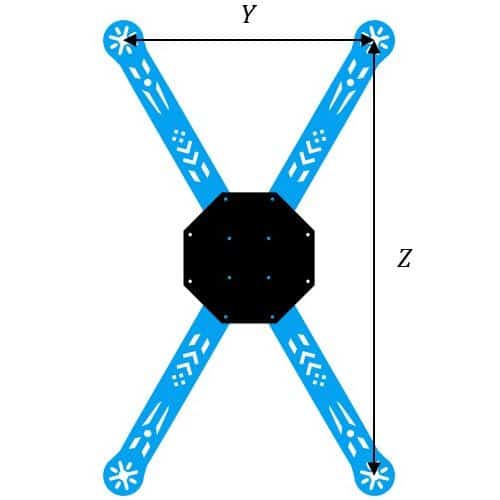
Fig 4. Minimum Frame and Prop Size
Overlapping the propellers is not recommended since the downward airflow of one quadcopter propeller will reduce the thrust efficiency of the propeller below. There is also a bit of side to side airflow due to tip vortices, so you want to allow for some spacing between the propellers to avoid this effect.
Number of Blades
Two bladed propellers are more efficient at producing thrust as opposed to three or four bladed propellers (see Figure 5) so long as the tips do not reach supersonic speeds. For the purposes of quadcopter propellers, this is not a problem.

Fig 5. Number of Propellers
Adding blades increases the amount of thrust that is generated, but at the cost of efficiency.
You will see many drones that have 5-inch triple blade propellers. The aerodynamic environment of drones negates the inefficiencies of tri-blades in the 5-inch size. Tri blades also have a higher torque generation which makes the yaw axis of the quadcopter much more responsive.
There are 4, 5, and even 6 blade designs, but these have diminishing returns due to inefficiency.
Propeller Material
Propellers are usually made from a plastic compound, though carbon fiber propellers are also available. The type of material used to make the quadcopter propeller affect its stiffness and durability.
Most hobby drone pilots are using durable plastic propellers that are slightly flexible and bend when your drone crashes. This allows them to last much longer, and save you money in the long run. These propellers have a disadvantage of causing vibration as they rotate, which can affect the flight performance of your drone.
Carbon fiber propellers have a number of
Propeller Weight
For better flight performance, you want to go with lighter propellers as opposed to heavier ones. Lighter props have less moment of inertia, which means the motor needs to apply less torque to generate the same RPM. This also results in faster RPM changes which
The weight distribution greatly affects the amount of vibration that the propeller will generate. A perfectly balanced prop will produce next to no vibration, while an unbalanced prop will affect the flight performance, and will sound terrible.
Bull-Nose Propellers
The more surface area

Fig 6. Bull Nose Propeller
Bull-nose quadcopter propellers have a greater surface
The added surface area of the bull-nose propeller means that you are adding weight, especially further away from the hub. This increases the moment of inertia of the
Bull-nose propellers are commonly used on small racing frames to gain a higher thrust at a smaller size.
Quadcopter Propeller Sizing
When selecting propeller sizing you need to understand the format that manufacturers use. There are two common formats that are used: LxPxB or LLPPxB.
L represents the length, P is the pitch, and B is the number of blades. You may also see a BN designation that stands for bull-nose.
You may also see an R or a C after the sizing numbers. The R stands for
Folding Propellers
There are many drones that are designed to highly portable so you can easily take them anywhere with you. To accomplish this, foldable propellers are included in the design (see Figures 7 and 8).

Fig 7. Foldable Propellers
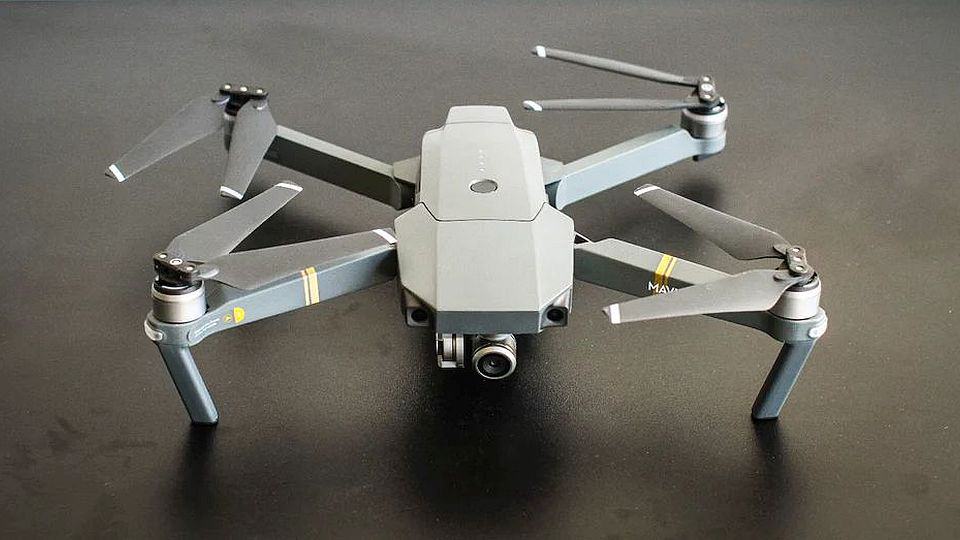
Fig 8. Foldable Propellers
At the high RPMs needed to generate lift to fly your drone, the outward force due to the motor rotation is sufficient to keep the propeller in its proper position. So, when you take off and jam the throttle on high, you can be sure your drone will fly. The foldable propellers are designed to maintain balance, so you do not lose any thrust generation efficiency.
There is a slight advantage that a foldable propeller has that a fixed prop doesn’t. On a fixed prop, when you push the throttle to high, all the motor torque is transferred to the propellers. With a foldable propeller, there is a bit of an absorbing effect that helps to cushion the impact on your drone. This will quickly balance out and the full torque will be applied to the propeller. The cushioning effect is beneficial to reduce shock impact on the camera.
Propeller Damage
If your quadcopter has crashed, be sure to take a careful look at the propellers for any damage. A few scrapes on the propeller are ok, but flying with nicked propellers will make it nosier, and increase vibration. This will have the effect of shortening the life of the
The quickest way to check for any damage is to run your fingers along the leading edge of the propeller. If you feel any major nicks, then it’s time to replace the propeller.
Be sure to keep a few extra propellers on hand if they need to be replaced. Most quadcopters that you buy come with extra propellers.
Remember, that there are two different directions that the propeller can rotate (see
Propeller Thrust and Speed
To know how much thrust a given propeller will produce, you must examine motor thrust test data which most manufacturers provide. The same propeller on two different motors can have vastly different performance due to variances in design, torque, power, and RPM.
However, these bench tests are done in a static
Be sure to take this into account when you are sizing your propeller and drone motor.
Quadcopter Propeller Summary
If you are building your own drone, then you will have a better idea of the options available to you as you select the propeller for your quadcopter.

